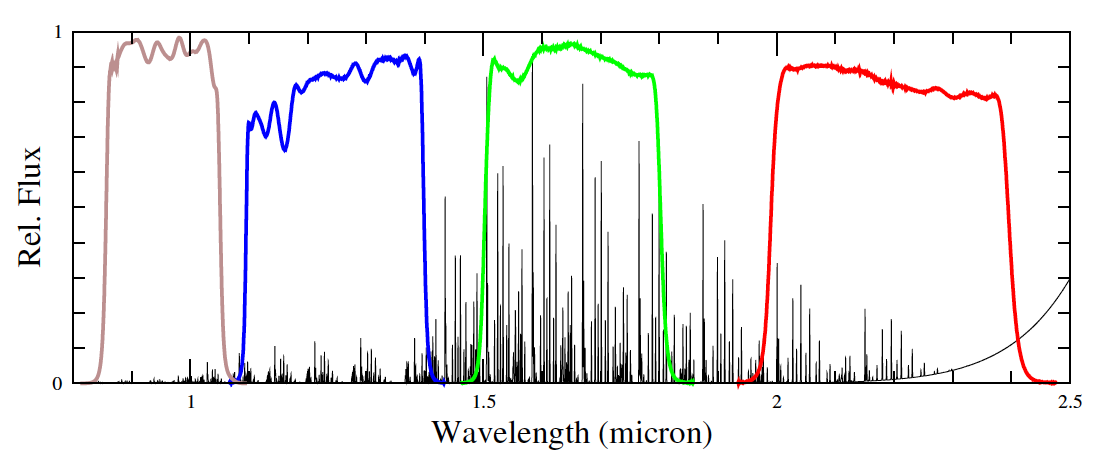Near IR Observing
The Atmosphere
Atmospheric extinction is relatively low in the near infrared. While we do not yet have measurements from the LBT, a reasonable estimate is 0.1, 0.07 and 0.04 mag/airmass for J, H and K-bands, respectively on clear photometric nights. Exposure time calculators (ETCs) normally have these default corrections built in and the airmass of the proposed observation is an input variable. The various molecules in the atmosphere, primarily water, also have strong rotational and vibrational transitions across the near-infrared window, causing significant absorption at certain wavelengths.
The plot above shows the atmospheric absorption in the near infrared, from 0.8 to 2.5 microns, with the LUCI zJHK filter bandpasses shown for reference.
The plot above shows the atmospheric emission over the same range, from 0.8 to 2.5 microns, with the LUCI zJHK filter bandpasses shown for reference. The two major contributions to this background emission in the near infrared are thermal blackbody radiation and line emission from OH radicals. The OH emission dominates the background in the zJH bands, while in K the background from OH and thermal emission are approximately equal.
OH emission varies by several tens of percent over a few minutes timescale. This is the basis for the well-known near-IR recommendation to dither your observations about once a minute for imaging, and as fast as is reasonable given other constraints for spectroscopy.
Moonlight also contributes to the background seen in near-infrared observations. The degree depends on the phase of the moon, and how close to the moon one is observing. Moonlight is relatively blue so shorter wavelengths are more strongly affected than longer wavelengths.
Weather and seeing are important factors to consider. They should be clearly stated as constraints on all programs. Clouds act like neutral density filters only on the source flux, but the background is still collected. Clear-sky seeing does not change the source flux, but does affect the number of pixels over which you extract your data and also affects the slit-losses in fixed slit width spectroscopy. In either case, a factor of two change in the constraint (half the source flux blocked by clouds, or an increase of the seeing from 1 to 2 arcsec) requires a factor of four change in exposure time to reach a comparable SNR as originally planned. Thus it does not make any sense to observe programs when the weather or seeing constraints are not met, and it is always a good idea to have backup programs available to do in poorer conditions than needed for the primary science targets.
Dithering
Dithering allows for removal of instrumental signatures and sky background from RAW data. For sky removal, the largest structure you are trying to measure must be offset completely. To keep the contribution to the noise from the background down, sky subtraction is done using a number of exposures around each science image. For very extended sources, this often requires moving completely off source to obtain a separate measurement of the sky. In spectroscopic observations you are further constrained to move in one dimension by the need to keep your science target somewhere along the spatial direction of the slit, but the same considerations apply.
Acquiring Bright Targets
It is sometimes helpful to cross two filters not normally used together. Crossed filters are useful for acquiring bright targets like telluric standards for spectroscopic calibration. The useful combinations are listed here.



